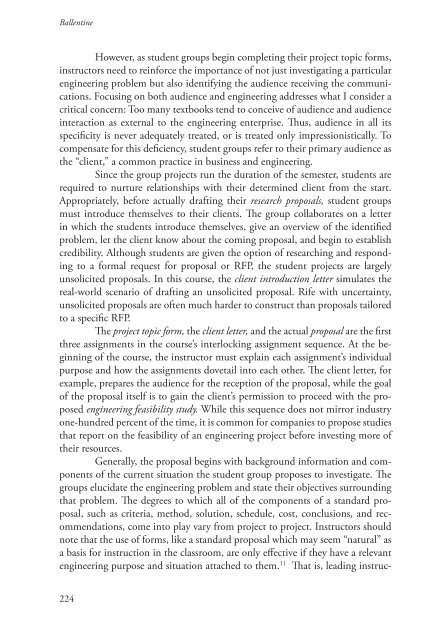Design Discourse - Composing and Revising Programs in Professional and Technical Writing, 2010a
Design Discourse - Composing and Revising Programs in Professional and Technical Writing, 2010a
Design Discourse - Composing and Revising Programs in Professional and Technical Writing, 2010a
Create successful ePaper yourself
Turn your PDF publications into a flip-book with our unique Google optimized e-Paper software.
Ballent<strong>in</strong>e<br />
However, as student groups beg<strong>in</strong> complet<strong>in</strong>g their project topic forms,<br />
<strong>in</strong>structors need to re<strong>in</strong>force the importance of not just <strong>in</strong>vestigat<strong>in</strong>g a particular<br />
eng<strong>in</strong>eer<strong>in</strong>g problem but also identify<strong>in</strong>g the audience receiv<strong>in</strong>g the communications.<br />
Focus<strong>in</strong>g on both audience <strong>and</strong> eng<strong>in</strong>eer<strong>in</strong>g addresses what I consider a<br />
critical concern: Too many textbooks tend to conceive of audience <strong>and</strong> audience<br />
<strong>in</strong>teraction as external to the eng<strong>in</strong>eer<strong>in</strong>g enterprise. Thus, audience <strong>in</strong> all its<br />
specificity is never adequately treated, or is treated only impressionistically. To<br />
compensate for this deficiency, student groups refer to their primary audience as<br />
the “client,” a common practice <strong>in</strong> bus<strong>in</strong>ess <strong>and</strong> eng<strong>in</strong>eer<strong>in</strong>g.<br />
S<strong>in</strong>ce the group projects run the duration of the semester, students are<br />
required to nurture relationships with their determ<strong>in</strong>ed client from the start.<br />
Appropriately, before actually draft<strong>in</strong>g their research proposals, student groups<br />
must <strong>in</strong>troduce themselves to their clients. The group collaborates on a letter<br />
<strong>in</strong> which the students <strong>in</strong>troduce themselves, give an overview of the identified<br />
problem, let the client know about the com<strong>in</strong>g proposal, <strong>and</strong> beg<strong>in</strong> to establish<br />
credibility. Although students are given the option of research<strong>in</strong>g <strong>and</strong> respond<strong>in</strong>g<br />
to a formal request for proposal or RFP, the student projects are largely<br />
unsolicited proposals. In this course, the client <strong>in</strong>troduction letter simulates the<br />
real-world scenario of draft<strong>in</strong>g an unsolicited proposal. Rife with uncerta<strong>in</strong>ty,<br />
unsolicited proposals are often much harder to construct than proposals tailored<br />
to a specific RFP.<br />
The project topic form, the client letter, <strong>and</strong> the actual proposal are the first<br />
three assignments <strong>in</strong> the course’s <strong>in</strong>terlock<strong>in</strong>g assignment sequence. At the beg<strong>in</strong>n<strong>in</strong>g<br />
of the course, the <strong>in</strong>structor must expla<strong>in</strong> each assignment’s <strong>in</strong>dividual<br />
purpose <strong>and</strong> how the assignments dovetail <strong>in</strong>to each other. The client letter, for<br />
example, prepares the audience for the reception of the proposal, while the goal<br />
of the proposal itself is to ga<strong>in</strong> the client’s permission to proceed with the proposed<br />
eng<strong>in</strong>eer<strong>in</strong>g feasibility study. While this sequence does not mirror <strong>in</strong>dustry<br />
one-hundred percent of the time, it is common for companies to propose studies<br />
that report on the feasibility of an eng<strong>in</strong>eer<strong>in</strong>g project before <strong>in</strong>vest<strong>in</strong>g more of<br />
their resources.<br />
Generally, the proposal beg<strong>in</strong>s with background <strong>in</strong>formation <strong>and</strong> components<br />
of the current situation the student group proposes to <strong>in</strong>vestigate. The<br />
groups elucidate the eng<strong>in</strong>eer<strong>in</strong>g problem <strong>and</strong> state their objectives surround<strong>in</strong>g<br />
that problem. The degrees to which all of the components of a st<strong>and</strong>ard proposal,<br />
such as criteria, method, solution, schedule, cost, conclusions, <strong>and</strong> recommendations,<br />
come <strong>in</strong>to play vary from project to project. Instructors should<br />
note that the use of forms, like a st<strong>and</strong>ard proposal which may seem “natural” as<br />
a basis for <strong>in</strong>struction <strong>in</strong> the classroom, are only effective if they have a relevant<br />
eng<strong>in</strong>eer<strong>in</strong>g purpose <strong>and</strong> situation attached to them. 11 That is, lead<strong>in</strong>g <strong>in</strong>struc-<br />
224


















